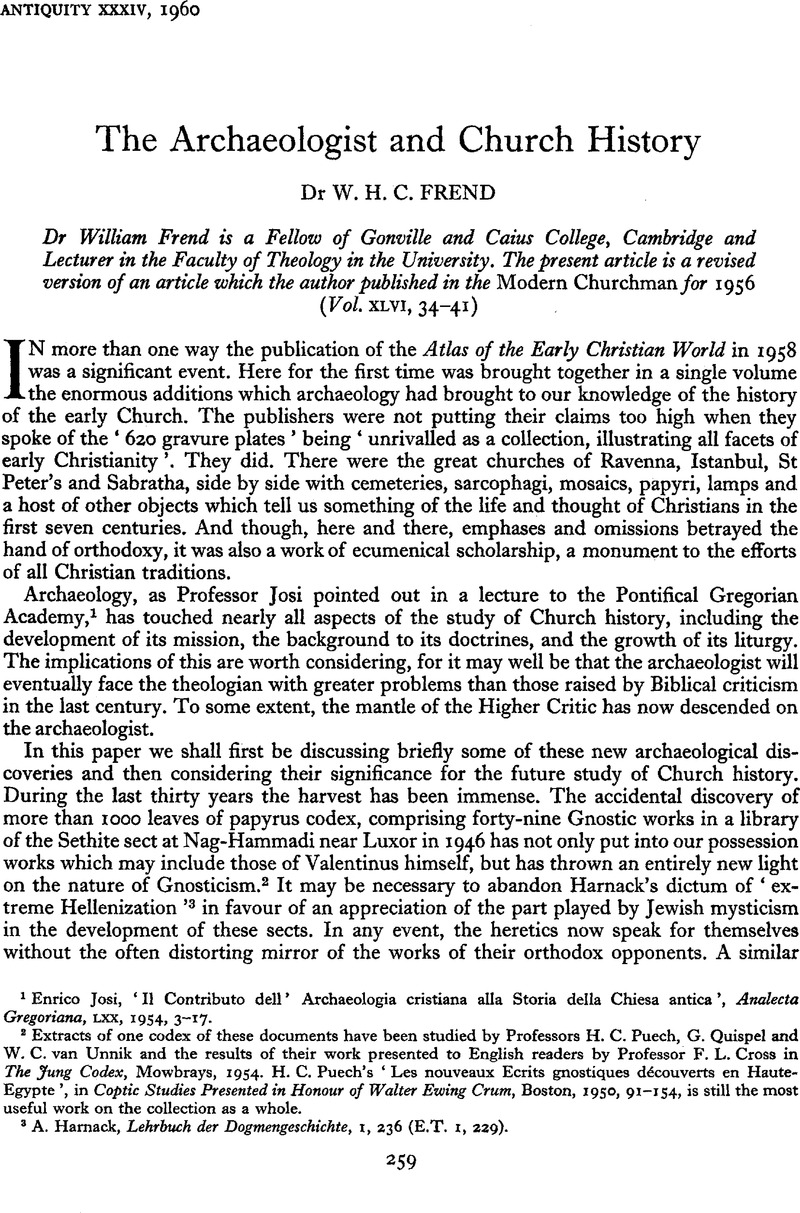No CrossRef data available.
Published online by Cambridge University Press: 02 January 2015

1 Enrico Josi, ‘Il Contributo dell’ Archaeologia cristiana alla Storia della Chiesa antica’, Analecta Gregoriana, LXX, 1954, 3-17.
2 Extracts of one codex of these documents have been studied by Professors H. C. Puech, G. Quispel and W. C. van Unnik and the results of their work presented to English readers by Professor F. L. Cross in The Jung Codex, Mowbrays, 1954. H. C. Puech’s ‘Les nouveaux Ecrits gnostiques découverts en Haute- Egypte’, in Coptic Studies Presented in Honour of Walter Ewing Crum, Boston, 1950, 91-154, is still the most useful work on the collection as a whole.
3 A. Harnack, Lehrbuch der Dogmengeschichte, 1, 236 (E.T. 1, 229).
4 A. Gesché, ‘L’âme humaine de Jésus, dans La Christologie du IVe. s.’, in Revue d’Histoire Ecclésiastique, LIV, (1959) 385 f.
5 Schmidt’s description of the event is given in his paper, Neue Origiinalquellen des Manichaismus aus Aegypten, Stuttgart, 1933.
6 Epiphanios, Panarion (ed. Holl), 68.
7 The most useful estimates of the results of the excavations are: J. M. C. Toynbee, ‘The Shrine of St Peter in its Historical Setting’, Journal of Roman Studies, XLIII, 1953, 1-26; J. Carcopino, Etudes d’Histoire chrétienne, 1953, 99 f.; O. Cullmann, Petrus, 1952, 73-169 (E.T. 1953, pp. 132 ff.); and J. M. C. Toynbee and J. Ward-Perkins, The Shrine of St Peter and the Vatican Excavations, Longmans, 1956.
8 No stratigraphical sections were published in the official Report. Cf. the author in Journal of Theological Studies, N.S. VIII, 1957, 159-62.
9 This lack is in marked contrast to the great number of third century invocations to SS Peter and Paul which adorn the walls of the Memoria of the Apostles beneath the present church of San Sebastiano. See H. Chadwick, ‘St Peter and Paul in Rome’, Journal of Theological Studies, N.S. VIII, 1957, 31 ff.
10 The opinion of Toynbee and Ward-Perkins, op. cit. 159, is worth quoting. ‘That the Christian community of the mid-second century did in fact believe St Peter to be buried in approximately this spot, and that the builders of the Red Wall in trenching for their foundations, did hit upon one end of a deeply buried grave, which was promptly identified as that of St Peter, is a hypothesis that would explain a great deal that is otherwise puzzling in the archaeological record.’ The work by E. Kirschbaum, S. J. The Tombs of St Peter and St Paul (E.T. London, 1959) does not advance the argument.
11 Described by André Berthier, Les Vestiges du Christianisme antique dans la Numidie centrale, Algiers, 1942.
12 Augustine, Enarratio in Psalmum, 132, 6. A. Berthier, op. cit., 205 ff.; W. H. C. Frend, The Donatist Church, Oxford, 1952, Ch. IV.
13 See Augustine, Letters 93 and 185.
14 J. Scherer, ‘Entretien d’Origéne avec Héraclide et les Evêques ses collègues sur le Père, le Fils et l’Ame’ (Publications de la Société Fouadi de Papyrologie, Textes et Documents, IX) Cairo, 1949, p. 1.
15 Ibid., Ch. 24 (Scherer, p. 166).
16 Ibid., Chs. 24-27.
17 C. Schmidt and H. J. Polotsky, ‘Ein Mani-Fund in Aegypten’, Sitzungsberichte der Berliner Akademie der Wissenschaften, 1933, Phil. Hist. Klasse, 4-89, at pp. 41-42 (Mani, Kephalaion, 154).
18 Ibid., pp. 42-46 (Mani, Kephalaion, 154).
19 See G. Quispel, ‘The Gospel of Thomas in the New Testament’, Vigiliae Christianae, XI, 1957, 187-201, and the author’s talk on the BBC, published by the Listener, 3 March, 1960, p. 389-90.
20 Lt.-Col. A. W. Meates, The Roman Villa at Lullingstone, Kent, 1955, Chs. XII-XIV.
21 J. M. C. Toynbee, ‘Christianity in Roman Britain’, Journal of the British Archaeological Association, XVI, 1953, 15.
22 For instance, fragments of Bk. 18 of the Kέστoi of Julius Africanus written not later than 235 were preserved on the back of a tax register dated to the reign of Tacitus (275-6). See W. Bauer, Rechtgläubigkeit una Ketzerei, Tubingen, 1934, 162.
23 For the intense interest taken in theological problems by the populace in Constantinople in the 4th century, see Gregory of Nazianze, De Deitate Filii, Patrologia Graeco-Latina, 46, 557B.
24 Pap. Rylands Greek, 457, containing parts of John 18. 31-33 and 18. 37-38. Published by C. H. Roberts, An Unpublished Fragment of the Fourth Gospel, Manchester, 1935.
25 C. H. Kraelíng, ‘A Greek Fragment of Tatian’s Diatessaron from Doura’, Studies and Documents, III, 193s.
26 Published by Carlo Cechelli, Monumenti cristiano-eretici di Roma, Rome, 1944, at p. 100.